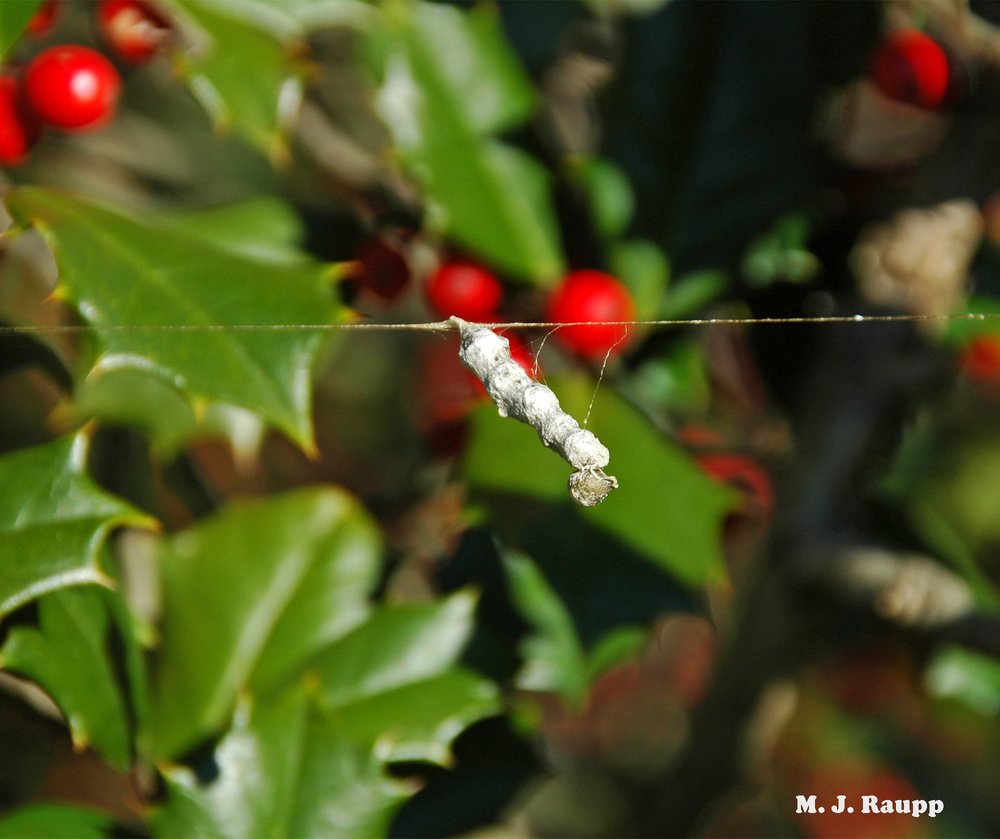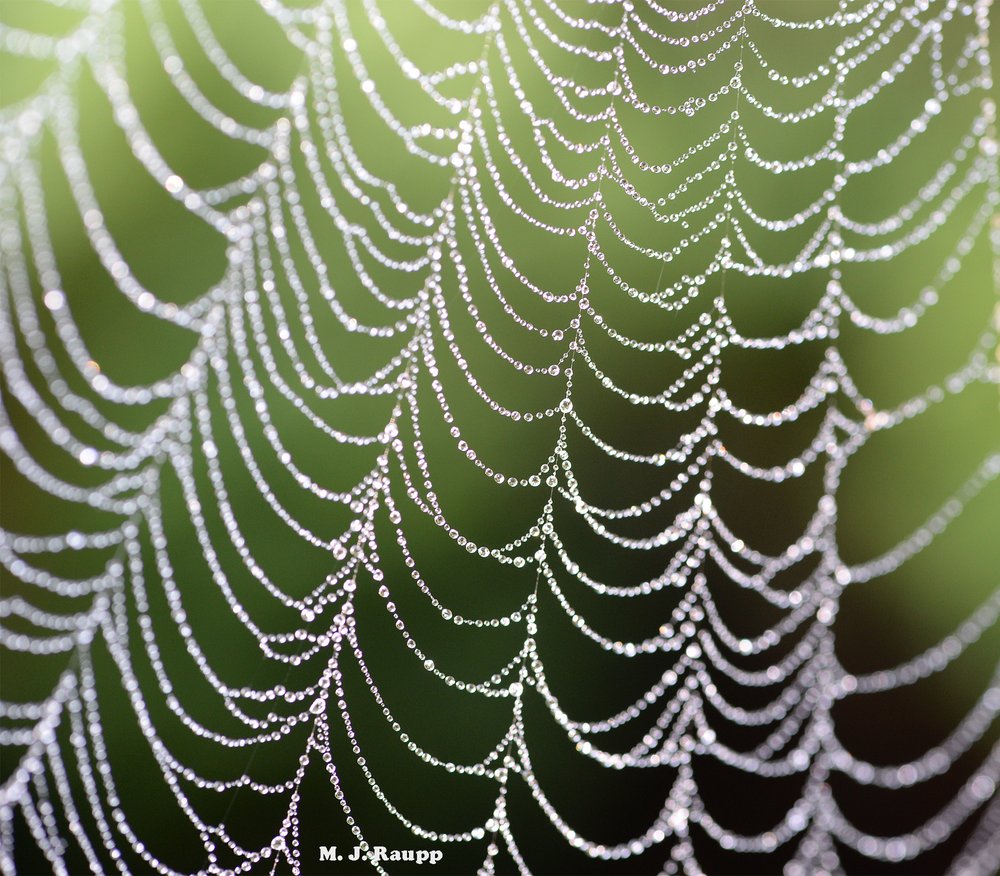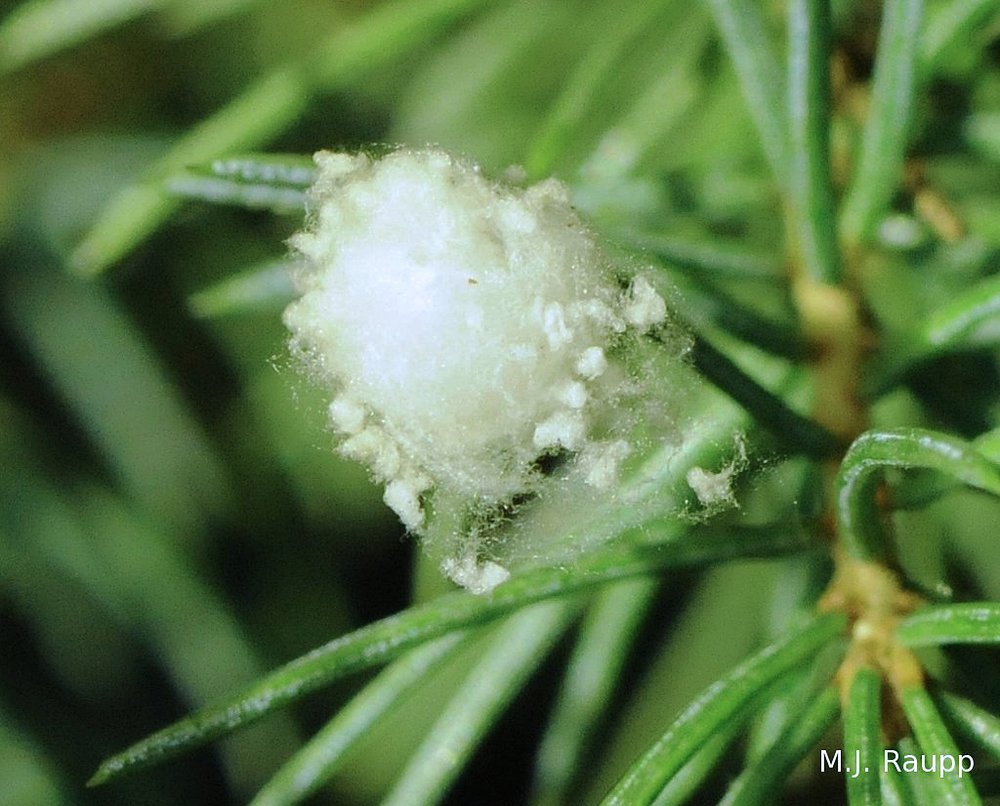
Several giant eyes help the red-backed jumping spider track its prey. Dazzling green fangs ensure prey don’t escape.

Spider egg sacs like these of the Basilica spider on holly sometimes inadvertently enter homes.
December 2021 will be remembered for many reasons, not the least of which is supply chain shortages that plague shoppers this holiday season. In addition to shortages of electronic devices and automobiles, choose-and-cut Christmas trees are somehow in short supply. Ah, but my favorite trusty tree farm had no shortage of trees and, in what has become a regular event, my holiday tree had no shortage of spiders. This year my Nordmann fir had at least one tiny but very entertaining jumping spider.
Jumping spiders are unlike their cousins, the well-known orb weavers made famous by E. B. White in Charlotte’s Web. As their name implies, jumping spiders are hunters, relentlessly on the prowl for small insects and other spiders which they stalk, grab, subdue, and pulverize with powerful fangs. They are among the most intelligent of all arthropods. Their tiny brains are able to form spatial maps and plan circuitous routes to sneak up on unsuspecting prey. They are highly entertaining to watch as they explore their environment in search of prey. Their eight eyes, two of which are extraordinarily large, allow them to precisely track moving prey. Their mating rituals are spectacularly complex and rival those of vertebrates like Bower Birds. You can watch them hunt and court at this link: https://www.nationalgeographic.com/animals/article/160121-jumping-spiders-animals-science
After bringing a field-grown Christmas tree into the house, I found this little jumping spider touring my houseplants. Once the stare-down with the camera guy was finished, the spider continued its explorations. Watch how it takes a shortcut from one leaf to another at normal and one third speed, hence the name jumping spider!

When morning dew glistens on silken strands, it's not hard to imagine why shimmering tinsel conjures thoughts of beautiful spider webs.
Other spiders play important roles in the anthology of holiday trees and their decorations. Each year as we put the finishing touches on our holiday tree, a serious debate arises regarding the quantity of tinsel necessary to complete the task. Some years ago, I explored the murky origins of tinsel. To some, the silvery strands of unknown composition evoke images of glistening icicles or shimmering crystals of frost on evergreen branches. But how did tinsel become part of a holiday tradition in so many households? To aficionados of arachnids, the tradition of festive tinsel has several different origins. One Christian story tells of Mary’s harrowing escape from Roman soldiers as she and Jesus hid in the hills near Bethlehem. With Herod’s legion in hot pursuit, Mary entered a cave seeking refuge. Spiders quickly sealed the entrance with silk and when soldiers arrived and saw the undisturbed webs, they disregarded the cave as a hideaway and continued their search elsewhere. Often maligned spiders saved the day! Since that time, tinsel has been strung on Christmas trees to represent a glistening spider web and to commemorate the spider’s miraculous deed.
Other tinsel legends from Germany and the Ukraine tell of spiders escaping the lethal brooms of housekeepers by hiding in dark corners of the home during preparations for holiday celebrations. After exiting their redoubts on Christmas Eve, spiders excitedly explored the evergreen trees that had been brought inside and then left behind glorious cloaks of gossamer webs. When Father Christmas arrived that night and saw the gray spider webs, he miraculously changed them into sparkling silver strands, much to the delight of families who viewed the trees on Christmas morning. Since that time, tinsel has been strung as a symbol of the remarkable event.
In the wild, jumping spiders prowl vegetation looking for prey and, apparently, amuse themselves by taking tiny bungee jumps from high places.

Spider egg sacs like these of the Basilica spider on holly sometimes inadvertently enter homes.
Many spiders survive winter’s chill as eggs protected in silken sacs. If the spider’s last haunt was a spruce or fir, then egg sacs may enter homes as stowaways on Christmas trees. In the warmth of holiday homes, eggs hatch and humans may be recipients of dozens of unexpected visitors. If you discover a spider egg sac on your Christmas tree or fresh evergreen boughs, simply pluck off a small piece of infested branch and place it and the egg sac outside on a shrub. This will allow the spiders to hatch just in time to deliver a deferred holiday gift of pest control in your garden. And as for my adorable jumping spider, well prey is scarce during winter months in my home. My spider was released on a hemlock where overwintering woolly adelgids may serve up a holiday treat for this clever hunter.
Acknowledgements
We thank the Maryland Christmas Tree Association for providing the inspiration for this episode. The fascinating article “The execution of planned detours by spider-eating predators” by Fiona R. Cross and Robert R. Jackson was used as a reference for this episode.
No comments:
Post a Comment